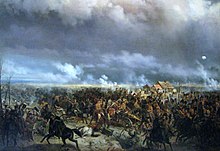
Back Congreve’sche Rakete German Cohete Congreve Spanish Congreve suziri Basque Congreve-raketti Finnish Fusée Congreve French רקטת קונגריב HE Congreve-rakéta Hungarian Roket congreve ID Razzo Congreve Italian コングリーヴ・ロケット Japanese



The Congreve rocket was a type of rocket artillery designed by British inventor Sir William Congreve in 1808.[1][2] The design was based upon the rockets deployed by the Kingdom of Mysore against the East India Company during the Second, Third, and Fourth Anglo-Mysore Wars. Lieutenant general Thomas Desaguliers, colonel commandant of the Royal Artillery at Woolwich, was impressed by reports of their effectiveness, and undertook several unsuccessful experiments to produce his own rocket weapons. Several captured Mysorean rockets were sent to Great Britain following the annexation of the Mysorean kingdom into British India following the death of Tipu Sultan in the siege of Seringapatam.[3]
The project was continued chiefly with William Congreve, who set up a research and development programme at the Woolwich Arsenal's laboratory. After development work was complete the rockets were manufactured in quantity further north, near Waltham Abbey, Essex. He was told that "the British at Seringapatam had suffered more from the rockets than from the shells or any other weapon used by the enemy."[4] "In at least one instance", an eyewitness told Congreve, "a single rocket had killed three men and badly wounded others."[5] The rockets were used by the British, the Russians and Paraguay during the nineteenth century.
- ^ Wragg, David W. (1973). A Dictionary of Aviation (1st ed.). Osprey. p. 97. ISBN 9780850451634.
- ^ Walker Jr., William (1864). Memoirs of the distinguished men of science of Great Britain living in the years 1807–8, and Appendix (2nd ed.). London: E. & F.N. Spon. pp. 34–35. doi:10.5962/bhl.title.28396.
- ^ Narasimha, Roddam (27 July 2011). "Rockets in Mysore and Britain, 1750–1850 A.D." (PDF). National Aeronautical Laboratory and Indian Institute of Science. Archived from the original on 27 July 2011.
- ^ Von Braun W, Ordway III F. I. History of rocketry and space travel, Nelson
- ^ Ley E (1958). Rockets, missiles, and space travel, Chapman & Hall, London